Comprehensive Report on Safety, Health and Environment Management
VerifiedAdded on 2023/06/10
|10
|1799
|367
Report
AI Summary
This report delves into the critical area of Safety, Health, and Environment (SHE) management, focusing on the challenges and strategies within the trucking industry. It begins with an introduction highlighting the growing importance of SHE, followed by a review of a published paper that examines the environmental impact and social sustainability issues faced by trucking companies, particularly concerning empty container truck trips. The report then discusses the importance of literature reviews in research, outlining the objectives and benefits of conducting them. It proceeds to analyze qualitative and quantitative data, differentiating between the two and providing examples relevant to the study. The report also explores alternative research strategies, such as experiments, surveys, and case studies, along with initial research ideas related to occupational safety and environmental impact within the transportation sector, ultimately focusing on container trucks and traffic management issues. The report concludes by summarizing the key findings and emphasizing the significance of SHE management in society.
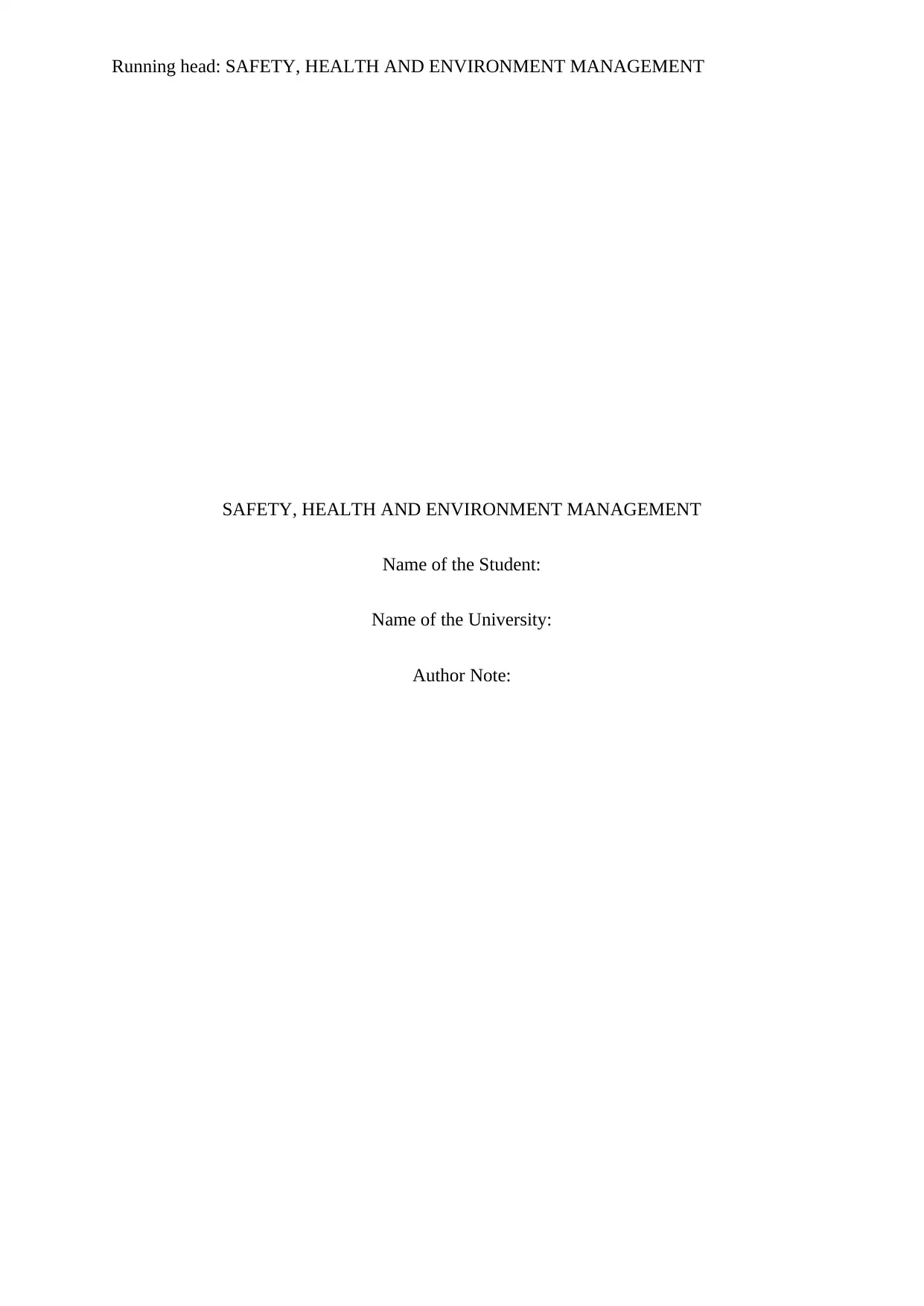
Running head: SAFETY, HEALTH AND ENVIRONMENT MANAGEMENT
SAFETY, HEALTH AND ENVIRONMENT MANAGEMENT
Name of the Student:
Name of the University:
Author Note:
SAFETY, HEALTH AND ENVIRONMENT MANAGEMENT
Name of the Student:
Name of the University:
Author Note:
Secure Best Marks with AI Grader
Need help grading? Try our AI Grader for instant feedback on your assignments.
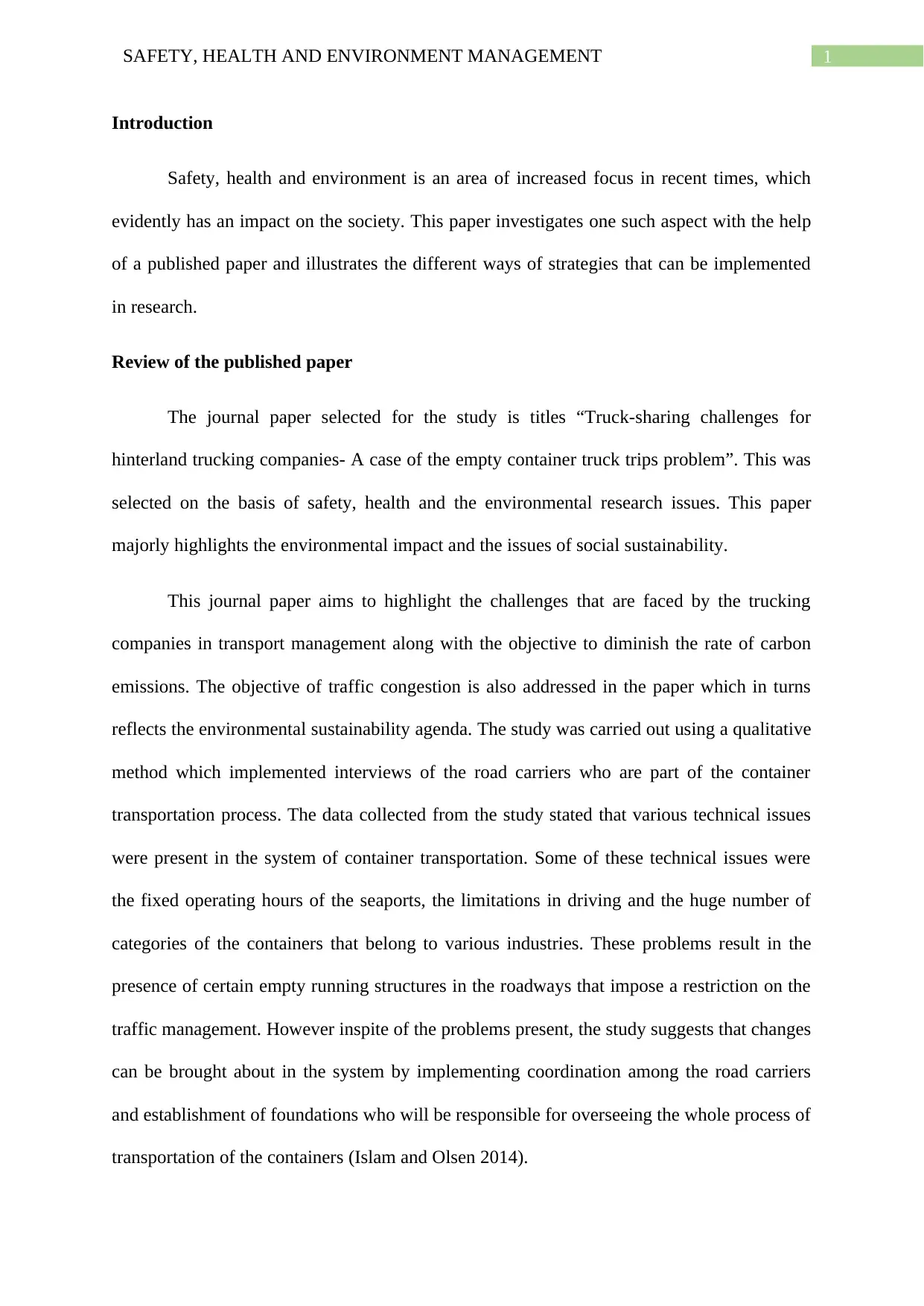
1SAFETY, HEALTH AND ENVIRONMENT MANAGEMENT
Introduction
Safety, health and environment is an area of increased focus in recent times, which
evidently has an impact on the society. This paper investigates one such aspect with the help
of a published paper and illustrates the different ways of strategies that can be implemented
in research.
Review of the published paper
The journal paper selected for the study is titles “Truck-sharing challenges for
hinterland trucking companies- A case of the empty container truck trips problem”. This was
selected on the basis of safety, health and the environmental research issues. This paper
majorly highlights the environmental impact and the issues of social sustainability.
This journal paper aims to highlight the challenges that are faced by the trucking
companies in transport management along with the objective to diminish the rate of carbon
emissions. The objective of traffic congestion is also addressed in the paper which in turns
reflects the environmental sustainability agenda. The study was carried out using a qualitative
method which implemented interviews of the road carriers who are part of the container
transportation process. The data collected from the study stated that various technical issues
were present in the system of container transportation. Some of these technical issues were
the fixed operating hours of the seaports, the limitations in driving and the huge number of
categories of the containers that belong to various industries. These problems result in the
presence of certain empty running structures in the roadways that impose a restriction on the
traffic management. However inspite of the problems present, the study suggests that changes
can be brought about in the system by implementing coordination among the road carriers
and establishment of foundations who will be responsible for overseeing the whole process of
transportation of the containers (Islam and Olsen 2014).
Introduction
Safety, health and environment is an area of increased focus in recent times, which
evidently has an impact on the society. This paper investigates one such aspect with the help
of a published paper and illustrates the different ways of strategies that can be implemented
in research.
Review of the published paper
The journal paper selected for the study is titles “Truck-sharing challenges for
hinterland trucking companies- A case of the empty container truck trips problem”. This was
selected on the basis of safety, health and the environmental research issues. This paper
majorly highlights the environmental impact and the issues of social sustainability.
This journal paper aims to highlight the challenges that are faced by the trucking
companies in transport management along with the objective to diminish the rate of carbon
emissions. The objective of traffic congestion is also addressed in the paper which in turns
reflects the environmental sustainability agenda. The study was carried out using a qualitative
method which implemented interviews of the road carriers who are part of the container
transportation process. The data collected from the study stated that various technical issues
were present in the system of container transportation. Some of these technical issues were
the fixed operating hours of the seaports, the limitations in driving and the huge number of
categories of the containers that belong to various industries. These problems result in the
presence of certain empty running structures in the roadways that impose a restriction on the
traffic management. However inspite of the problems present, the study suggests that changes
can be brought about in the system by implementing coordination among the road carriers
and establishment of foundations who will be responsible for overseeing the whole process of
transportation of the containers (Islam and Olsen 2014).
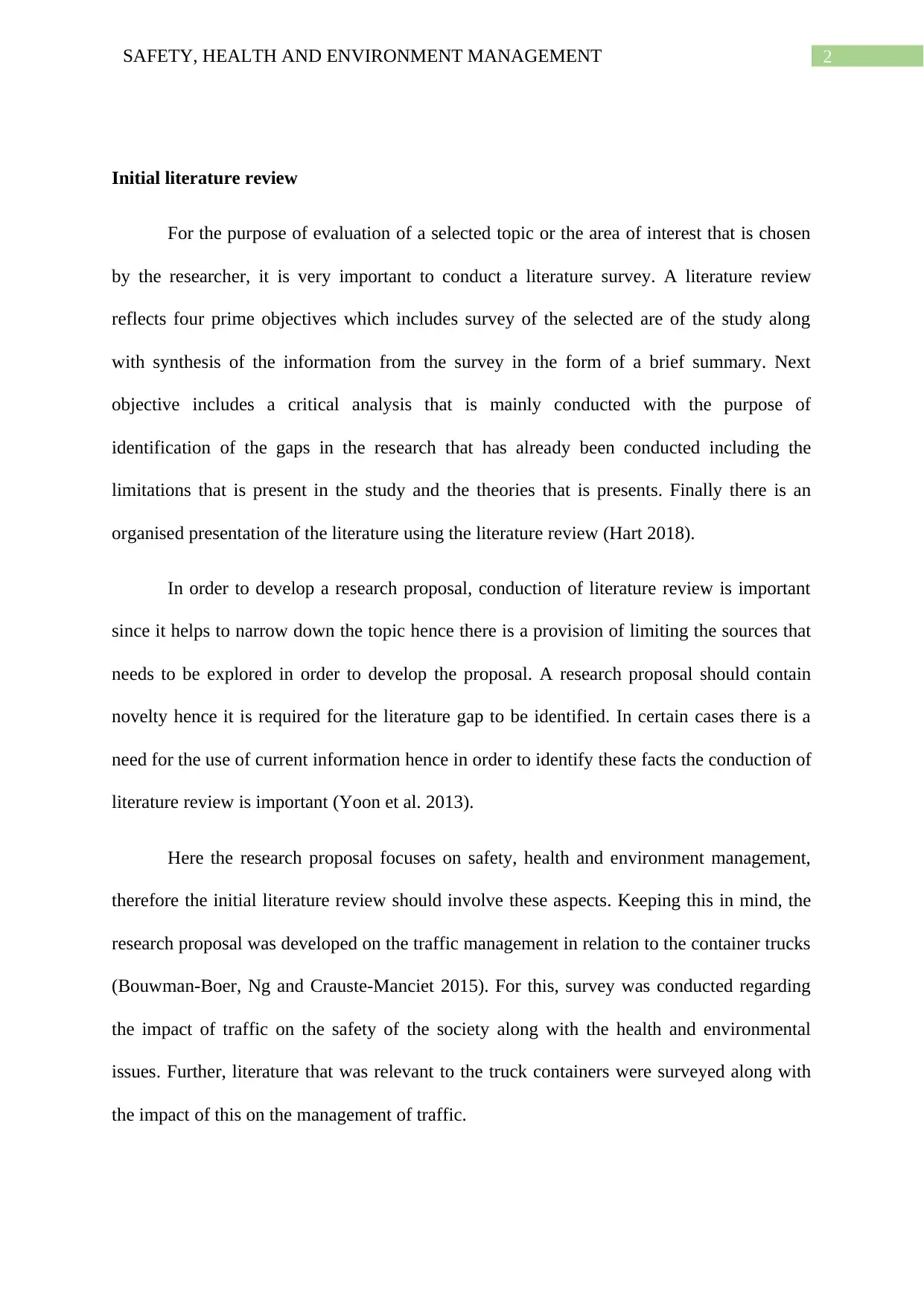
2SAFETY, HEALTH AND ENVIRONMENT MANAGEMENT
Initial literature review
For the purpose of evaluation of a selected topic or the area of interest that is chosen
by the researcher, it is very important to conduct a literature survey. A literature review
reflects four prime objectives which includes survey of the selected are of the study along
with synthesis of the information from the survey in the form of a brief summary. Next
objective includes a critical analysis that is mainly conducted with the purpose of
identification of the gaps in the research that has already been conducted including the
limitations that is present in the study and the theories that is presents. Finally there is an
organised presentation of the literature using the literature review (Hart 2018).
In order to develop a research proposal, conduction of literature review is important
since it helps to narrow down the topic hence there is a provision of limiting the sources that
needs to be explored in order to develop the proposal. A research proposal should contain
novelty hence it is required for the literature gap to be identified. In certain cases there is a
need for the use of current information hence in order to identify these facts the conduction of
literature review is important (Yoon et al. 2013).
Here the research proposal focuses on safety, health and environment management,
therefore the initial literature review should involve these aspects. Keeping this in mind, the
research proposal was developed on the traffic management in relation to the container trucks
(Bouwman-Boer, Ng and Crauste-Manciet 2015). For this, survey was conducted regarding
the impact of traffic on the safety of the society along with the health and environmental
issues. Further, literature that was relevant to the truck containers were surveyed along with
the impact of this on the management of traffic.
Initial literature review
For the purpose of evaluation of a selected topic or the area of interest that is chosen
by the researcher, it is very important to conduct a literature survey. A literature review
reflects four prime objectives which includes survey of the selected are of the study along
with synthesis of the information from the survey in the form of a brief summary. Next
objective includes a critical analysis that is mainly conducted with the purpose of
identification of the gaps in the research that has already been conducted including the
limitations that is present in the study and the theories that is presents. Finally there is an
organised presentation of the literature using the literature review (Hart 2018).
In order to develop a research proposal, conduction of literature review is important
since it helps to narrow down the topic hence there is a provision of limiting the sources that
needs to be explored in order to develop the proposal. A research proposal should contain
novelty hence it is required for the literature gap to be identified. In certain cases there is a
need for the use of current information hence in order to identify these facts the conduction of
literature review is important (Yoon et al. 2013).
Here the research proposal focuses on safety, health and environment management,
therefore the initial literature review should involve these aspects. Keeping this in mind, the
research proposal was developed on the traffic management in relation to the container trucks
(Bouwman-Boer, Ng and Crauste-Manciet 2015). For this, survey was conducted regarding
the impact of traffic on the safety of the society along with the health and environmental
issues. Further, literature that was relevant to the truck containers were surveyed along with
the impact of this on the management of traffic.
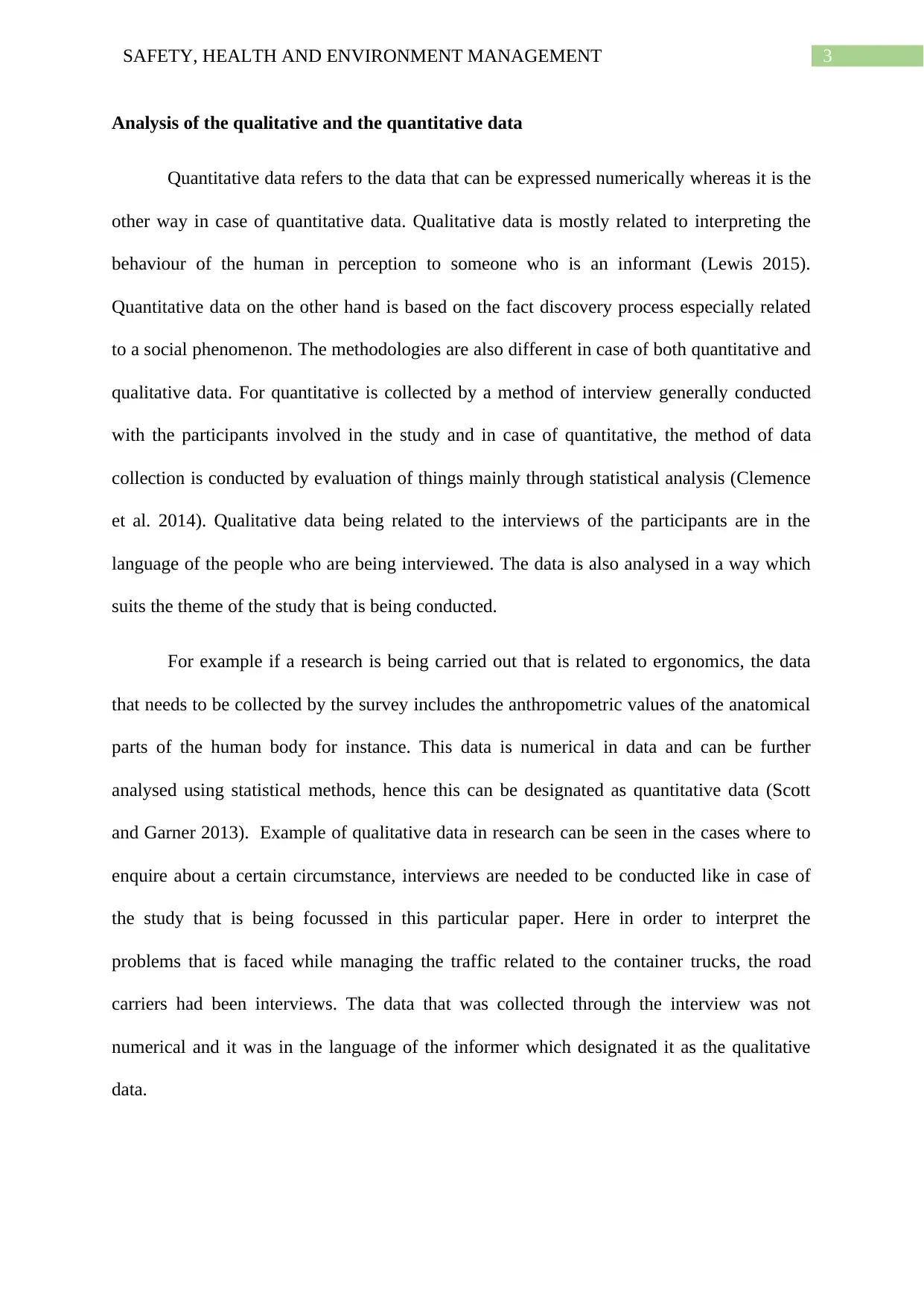
3SAFETY, HEALTH AND ENVIRONMENT MANAGEMENT
Analysis of the qualitative and the quantitative data
Quantitative data refers to the data that can be expressed numerically whereas it is the
other way in case of quantitative data. Qualitative data is mostly related to interpreting the
behaviour of the human in perception to someone who is an informant (Lewis 2015).
Quantitative data on the other hand is based on the fact discovery process especially related
to a social phenomenon. The methodologies are also different in case of both quantitative and
qualitative data. For quantitative is collected by a method of interview generally conducted
with the participants involved in the study and in case of quantitative, the method of data
collection is conducted by evaluation of things mainly through statistical analysis (Clemence
et al. 2014). Qualitative data being related to the interviews of the participants are in the
language of the people who are being interviewed. The data is also analysed in a way which
suits the theme of the study that is being conducted.
For example if a research is being carried out that is related to ergonomics, the data
that needs to be collected by the survey includes the anthropometric values of the anatomical
parts of the human body for instance. This data is numerical in data and can be further
analysed using statistical methods, hence this can be designated as quantitative data (Scott
and Garner 2013). Example of qualitative data in research can be seen in the cases where to
enquire about a certain circumstance, interviews are needed to be conducted like in case of
the study that is being focussed in this particular paper. Here in order to interpret the
problems that is faced while managing the traffic related to the container trucks, the road
carriers had been interviews. The data that was collected through the interview was not
numerical and it was in the language of the informer which designated it as the qualitative
data.
Analysis of the qualitative and the quantitative data
Quantitative data refers to the data that can be expressed numerically whereas it is the
other way in case of quantitative data. Qualitative data is mostly related to interpreting the
behaviour of the human in perception to someone who is an informant (Lewis 2015).
Quantitative data on the other hand is based on the fact discovery process especially related
to a social phenomenon. The methodologies are also different in case of both quantitative and
qualitative data. For quantitative is collected by a method of interview generally conducted
with the participants involved in the study and in case of quantitative, the method of data
collection is conducted by evaluation of things mainly through statistical analysis (Clemence
et al. 2014). Qualitative data being related to the interviews of the participants are in the
language of the people who are being interviewed. The data is also analysed in a way which
suits the theme of the study that is being conducted.
For example if a research is being carried out that is related to ergonomics, the data
that needs to be collected by the survey includes the anthropometric values of the anatomical
parts of the human body for instance. This data is numerical in data and can be further
analysed using statistical methods, hence this can be designated as quantitative data (Scott
and Garner 2013). Example of qualitative data in research can be seen in the cases where to
enquire about a certain circumstance, interviews are needed to be conducted like in case of
the study that is being focussed in this particular paper. Here in order to interpret the
problems that is faced while managing the traffic related to the container trucks, the road
carriers had been interviews. The data that was collected through the interview was not
numerical and it was in the language of the informer which designated it as the qualitative
data.
Secure Best Marks with AI Grader
Need help grading? Try our AI Grader for instant feedback on your assignments.
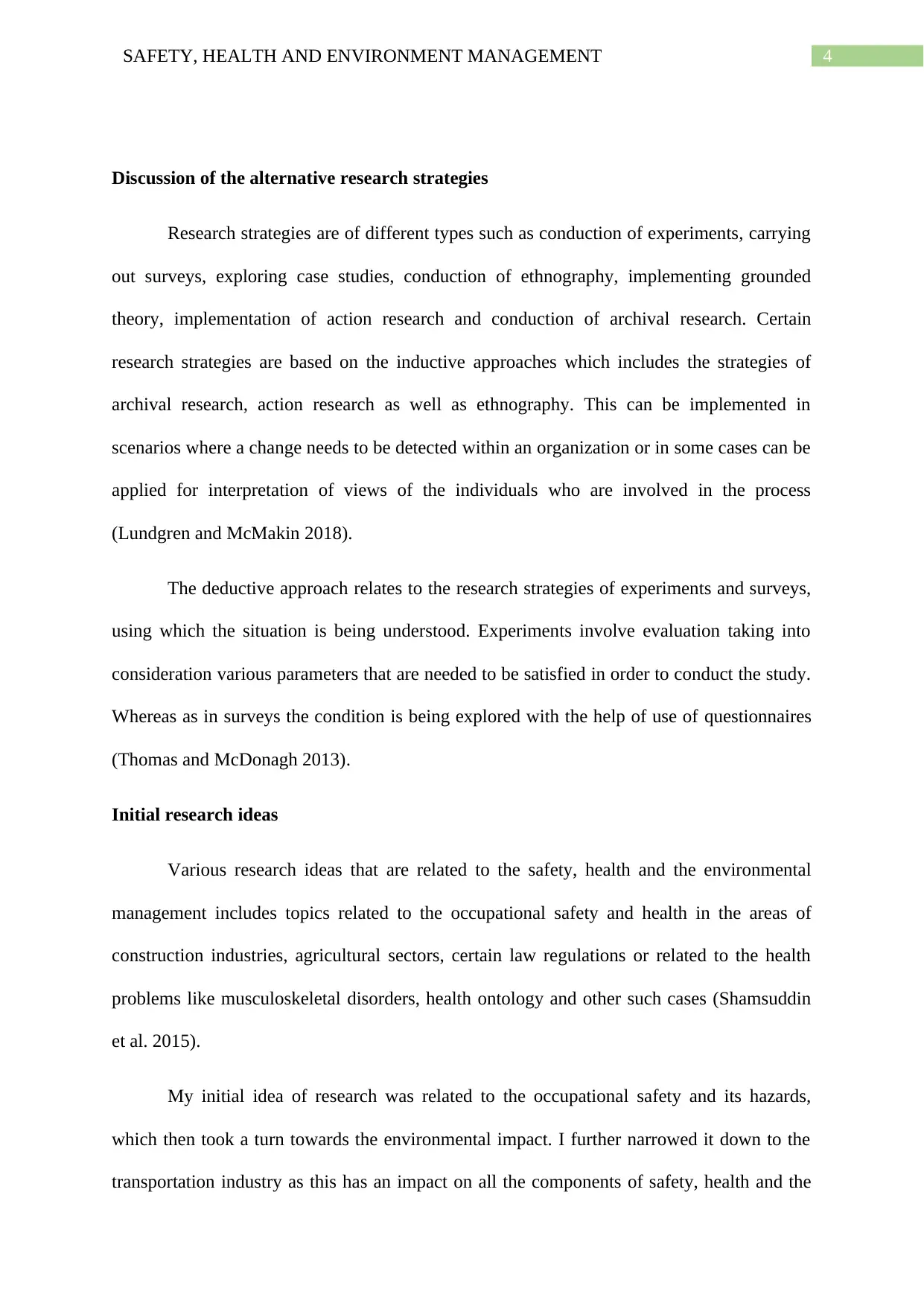
4SAFETY, HEALTH AND ENVIRONMENT MANAGEMENT
Discussion of the alternative research strategies
Research strategies are of different types such as conduction of experiments, carrying
out surveys, exploring case studies, conduction of ethnography, implementing grounded
theory, implementation of action research and conduction of archival research. Certain
research strategies are based on the inductive approaches which includes the strategies of
archival research, action research as well as ethnography. This can be implemented in
scenarios where a change needs to be detected within an organization or in some cases can be
applied for interpretation of views of the individuals who are involved in the process
(Lundgren and McMakin 2018).
The deductive approach relates to the research strategies of experiments and surveys,
using which the situation is being understood. Experiments involve evaluation taking into
consideration various parameters that are needed to be satisfied in order to conduct the study.
Whereas as in surveys the condition is being explored with the help of use of questionnaires
(Thomas and McDonagh 2013).
Initial research ideas
Various research ideas that are related to the safety, health and the environmental
management includes topics related to the occupational safety and health in the areas of
construction industries, agricultural sectors, certain law regulations or related to the health
problems like musculoskeletal disorders, health ontology and other such cases (Shamsuddin
et al. 2015).
My initial idea of research was related to the occupational safety and its hazards,
which then took a turn towards the environmental impact. I further narrowed it down to the
transportation industry as this has an impact on all the components of safety, health and the
Discussion of the alternative research strategies
Research strategies are of different types such as conduction of experiments, carrying
out surveys, exploring case studies, conduction of ethnography, implementing grounded
theory, implementation of action research and conduction of archival research. Certain
research strategies are based on the inductive approaches which includes the strategies of
archival research, action research as well as ethnography. This can be implemented in
scenarios where a change needs to be detected within an organization or in some cases can be
applied for interpretation of views of the individuals who are involved in the process
(Lundgren and McMakin 2018).
The deductive approach relates to the research strategies of experiments and surveys,
using which the situation is being understood. Experiments involve evaluation taking into
consideration various parameters that are needed to be satisfied in order to conduct the study.
Whereas as in surveys the condition is being explored with the help of use of questionnaires
(Thomas and McDonagh 2013).
Initial research ideas
Various research ideas that are related to the safety, health and the environmental
management includes topics related to the occupational safety and health in the areas of
construction industries, agricultural sectors, certain law regulations or related to the health
problems like musculoskeletal disorders, health ontology and other such cases (Shamsuddin
et al. 2015).
My initial idea of research was related to the occupational safety and its hazards,
which then took a turn towards the environmental impact. I further narrowed it down to the
transportation industry as this has an impact on all the components of safety, health and the
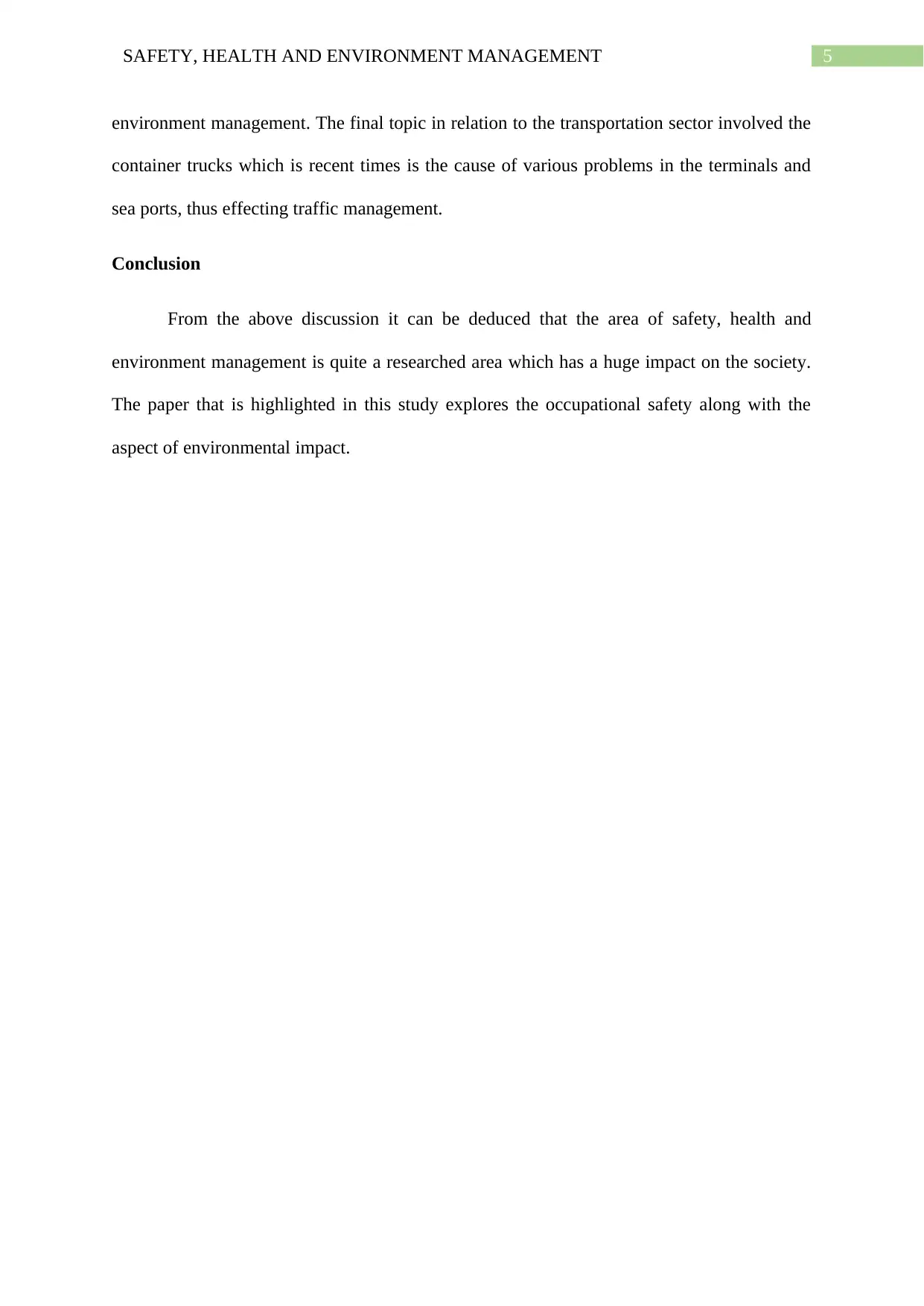
5SAFETY, HEALTH AND ENVIRONMENT MANAGEMENT
environment management. The final topic in relation to the transportation sector involved the
container trucks which is recent times is the cause of various problems in the terminals and
sea ports, thus effecting traffic management.
Conclusion
From the above discussion it can be deduced that the area of safety, health and
environment management is quite a researched area which has a huge impact on the society.
The paper that is highlighted in this study explores the occupational safety along with the
aspect of environmental impact.
environment management. The final topic in relation to the transportation sector involved the
container trucks which is recent times is the cause of various problems in the terminals and
sea ports, thus effecting traffic management.
Conclusion
From the above discussion it can be deduced that the area of safety, health and
environment management is quite a researched area which has a huge impact on the society.
The paper that is highlighted in this study explores the occupational safety along with the
aspect of environmental impact.
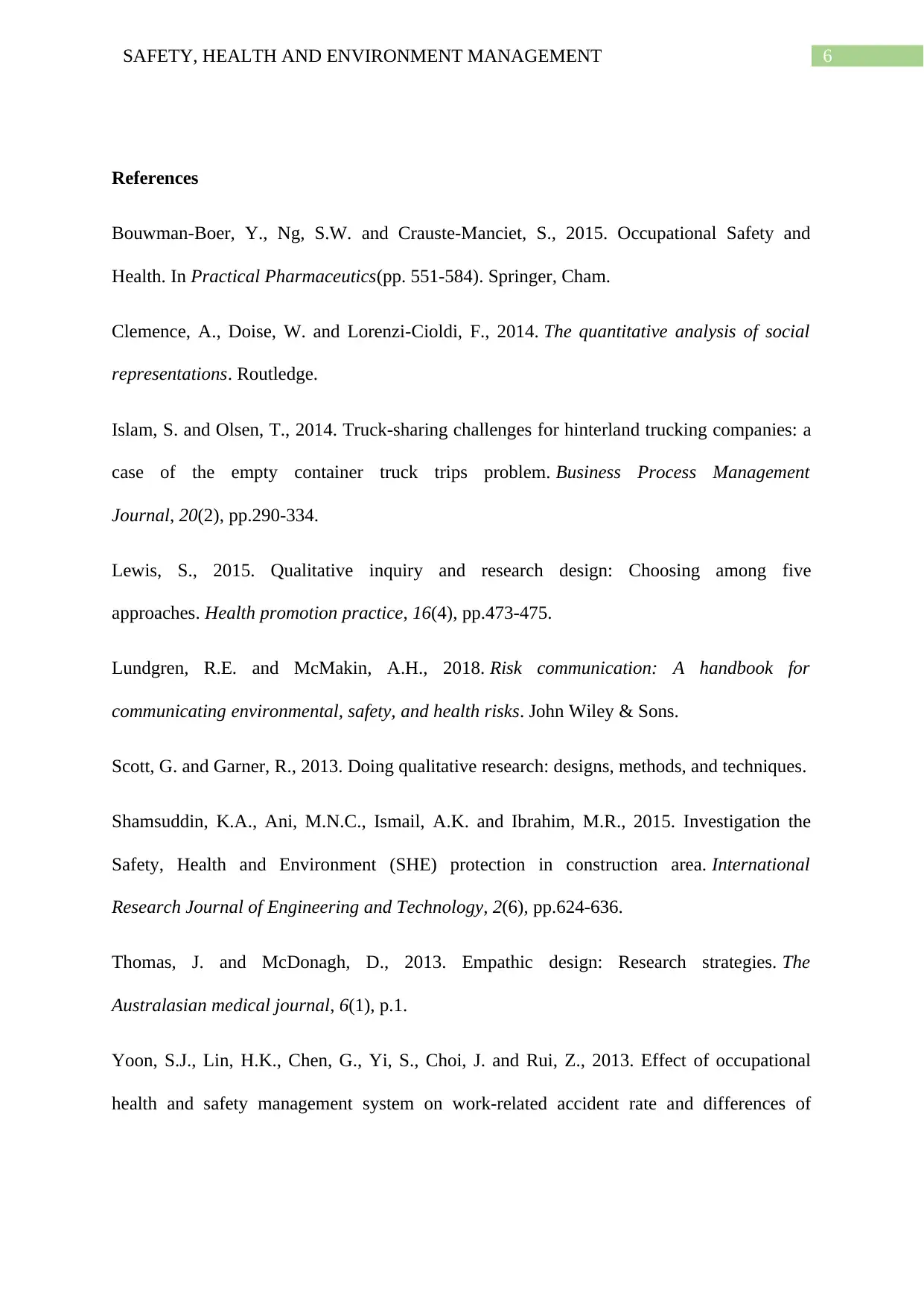
6SAFETY, HEALTH AND ENVIRONMENT MANAGEMENT
References
Bouwman-Boer, Y., Ng, S.W. and Crauste-Manciet, S., 2015. Occupational Safety and
Health. In Practical Pharmaceutics(pp. 551-584). Springer, Cham.
Clemence, A., Doise, W. and Lorenzi-Cioldi, F., 2014. The quantitative analysis of social
representations. Routledge.
Islam, S. and Olsen, T., 2014. Truck-sharing challenges for hinterland trucking companies: a
case of the empty container truck trips problem. Business Process Management
Journal, 20(2), pp.290-334.
Lewis, S., 2015. Qualitative inquiry and research design: Choosing among five
approaches. Health promotion practice, 16(4), pp.473-475.
Lundgren, R.E. and McMakin, A.H., 2018. Risk communication: A handbook for
communicating environmental, safety, and health risks. John Wiley & Sons.
Scott, G. and Garner, R., 2013. Doing qualitative research: designs, methods, and techniques.
Shamsuddin, K.A., Ani, M.N.C., Ismail, A.K. and Ibrahim, M.R., 2015. Investigation the
Safety, Health and Environment (SHE) protection in construction area. International
Research Journal of Engineering and Technology, 2(6), pp.624-636.
Thomas, J. and McDonagh, D., 2013. Empathic design: Research strategies. The
Australasian medical journal, 6(1), p.1.
Yoon, S.J., Lin, H.K., Chen, G., Yi, S., Choi, J. and Rui, Z., 2013. Effect of occupational
health and safety management system on work-related accident rate and differences of
References
Bouwman-Boer, Y., Ng, S.W. and Crauste-Manciet, S., 2015. Occupational Safety and
Health. In Practical Pharmaceutics(pp. 551-584). Springer, Cham.
Clemence, A., Doise, W. and Lorenzi-Cioldi, F., 2014. The quantitative analysis of social
representations. Routledge.
Islam, S. and Olsen, T., 2014. Truck-sharing challenges for hinterland trucking companies: a
case of the empty container truck trips problem. Business Process Management
Journal, 20(2), pp.290-334.
Lewis, S., 2015. Qualitative inquiry and research design: Choosing among five
approaches. Health promotion practice, 16(4), pp.473-475.
Lundgren, R.E. and McMakin, A.H., 2018. Risk communication: A handbook for
communicating environmental, safety, and health risks. John Wiley & Sons.
Scott, G. and Garner, R., 2013. Doing qualitative research: designs, methods, and techniques.
Shamsuddin, K.A., Ani, M.N.C., Ismail, A.K. and Ibrahim, M.R., 2015. Investigation the
Safety, Health and Environment (SHE) protection in construction area. International
Research Journal of Engineering and Technology, 2(6), pp.624-636.
Thomas, J. and McDonagh, D., 2013. Empathic design: Research strategies. The
Australasian medical journal, 6(1), p.1.
Yoon, S.J., Lin, H.K., Chen, G., Yi, S., Choi, J. and Rui, Z., 2013. Effect of occupational
health and safety management system on work-related accident rate and differences of
Paraphrase This Document
Need a fresh take? Get an instant paraphrase of this document with our AI Paraphraser
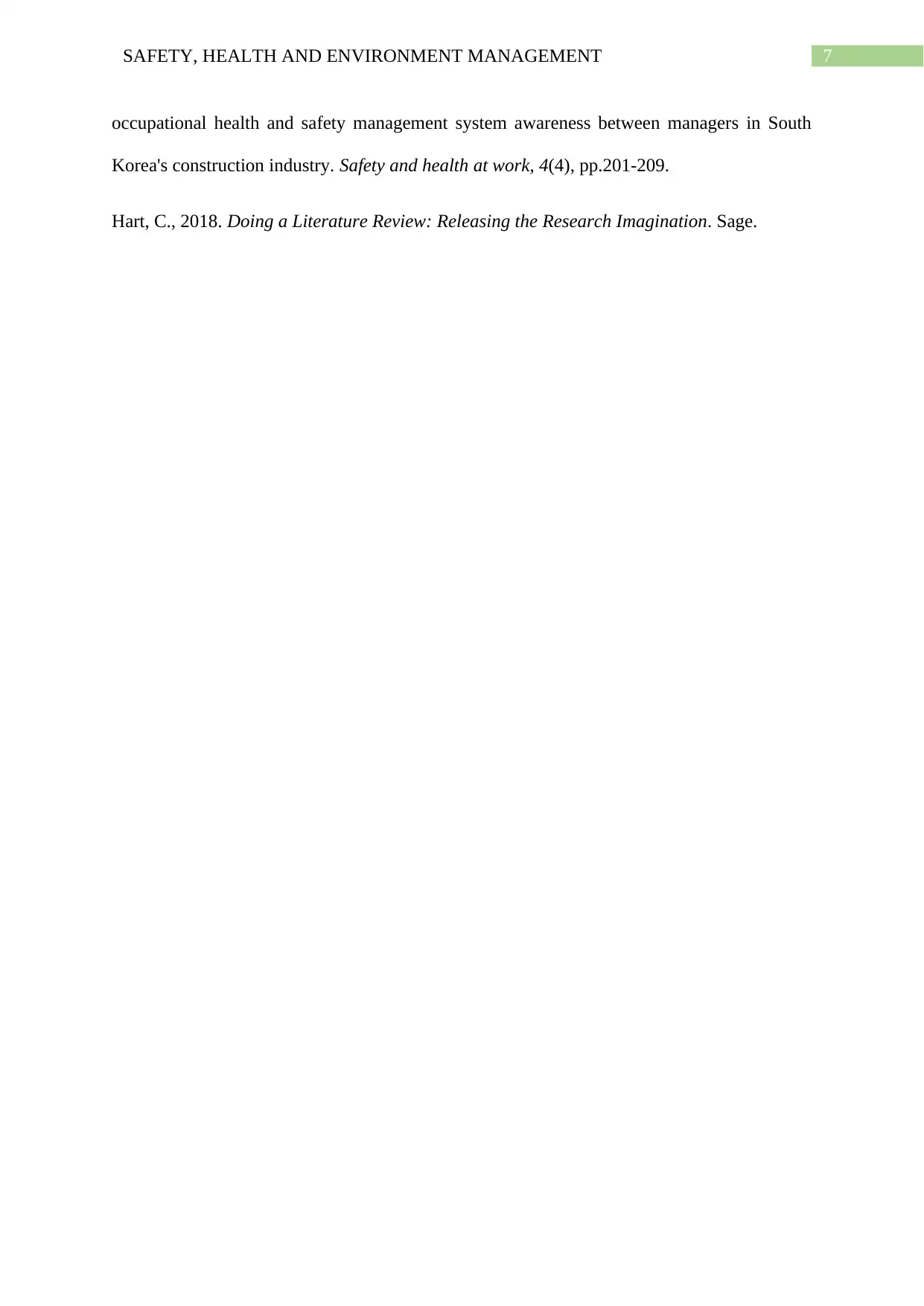
7SAFETY, HEALTH AND ENVIRONMENT MANAGEMENT
occupational health and safety management system awareness between managers in South
Korea's construction industry. Safety and health at work, 4(4), pp.201-209.
Hart, C., 2018. Doing a Literature Review: Releasing the Research Imagination. Sage.
occupational health and safety management system awareness between managers in South
Korea's construction industry. Safety and health at work, 4(4), pp.201-209.
Hart, C., 2018. Doing a Literature Review: Releasing the Research Imagination. Sage.
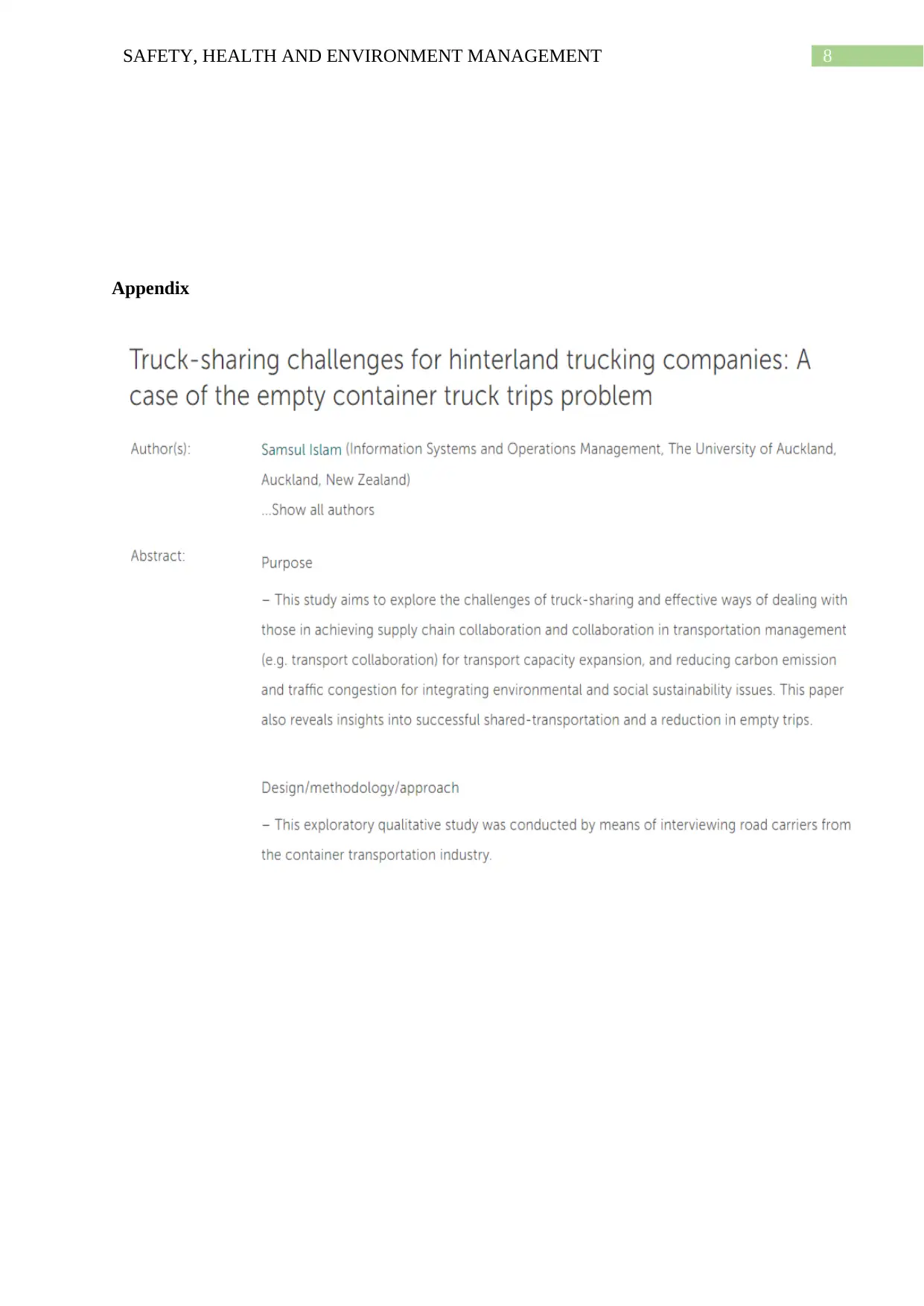
8SAFETY, HEALTH AND ENVIRONMENT MANAGEMENT
Appendix
Appendix
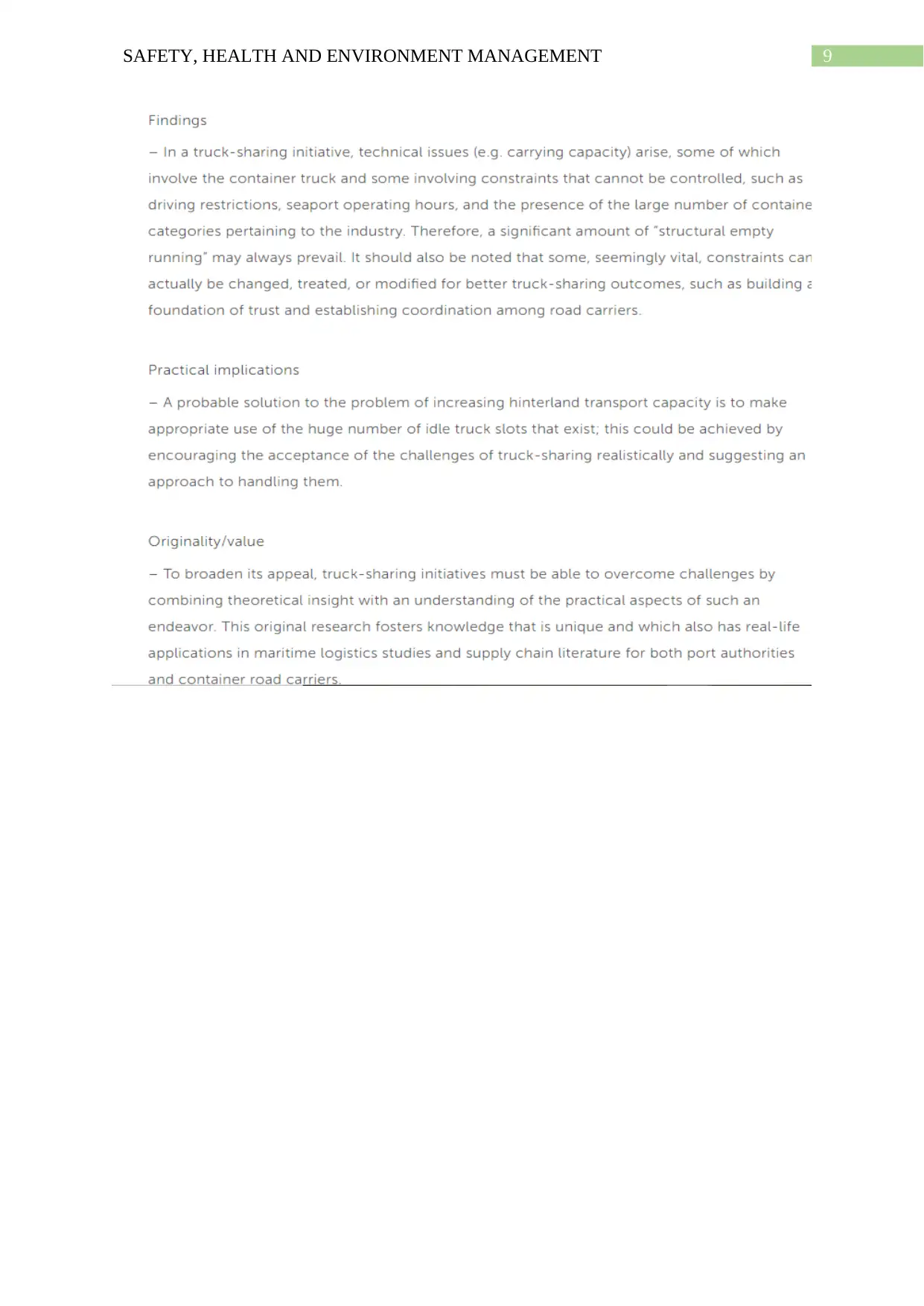
9SAFETY, HEALTH AND ENVIRONMENT MANAGEMENT
1 out of 10
Related Documents
Your All-in-One AI-Powered Toolkit for Academic Success.
+13062052269
info@desklib.com
Available 24*7 on WhatsApp / Email
![[object Object]](/_next/static/media/star-bottom.7253800d.svg)
Unlock your academic potential
© 2024 | Zucol Services PVT LTD | All rights reserved.





